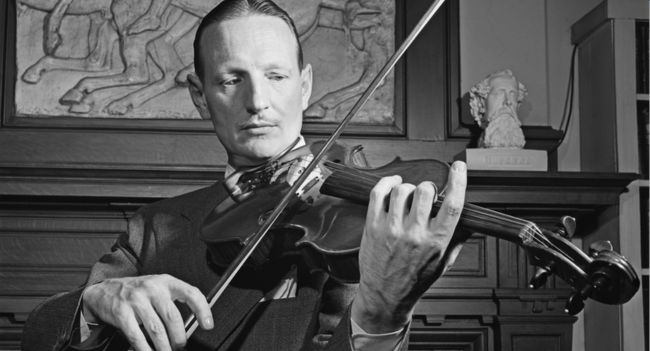Violist William Primrose, born in 1904, arrived on the music scene at just the right moment. For most of its history, the viola has been the neglected middle child of the string family, rich in neither repertoire nor virtuoso practitioners. But as the nineteenth century was ending, the British Lionel Tertis proved it was possible to make a career as a solo violist.
In 1894, the Paris Conservatoire appointed its first professor of viola, and in 1918 the excellent soloist Maurice Vieux acceded to the position. The time was ripe for a viola superstar to emerge. It might have been Paul Hindemith. Hindemith was a first-class instrumentalist, but he devoted more energy to composing than to playing. (He wrote the first of his many viola works in 1919.)
It was left to Primrose to establish the viola as the incontrovertible equal to its string siblings. With his virtuoso technique, richness of sound, and coloristic imagination, he was more than up to the job.
Primrose’s first position following the 1934 demise of the quartet was with Toscanini’s NBC Symphony, beginning in 1937. While playing in the orchestra, he also formed the Primrose Quartet, with illustrious symphony mates Oscar Shumsky and Josef Gingold on violin and Harvey Shapiro on cello.
In the early ’40s, Primrose began to seriously pursue a solo career. His success in this endeavor brought him into contact with the most important composers of twentieth-century viola repertoire: he commissioned the Bartók and Milhaud Second Concertos, inspired the composition of Britten’s Lachrymae, recorded the Walton Concerto with Walton conducting, and was an early advocate of Hindemith’s music. In addition, he made the first studio recording of Berlioz’s viola-heavy Harold in Italy.
In the midst of solo activities, Primrose never ceased playing chamber music. He performed and recorded often with Jascha Heifetz and either Emmanuel Feuermann or Gregor Piatigorsky on cello. In the ’50s and ’60s, the great Scot formed the Festival Piano Quartet with violinist Szymon Goldberg, cellist Nikolai Graudan, and pianist Victor Babin. And in the late ’50s, he made wonderful recordings of the Mozart quintets with the Griller Quartet.
Recordings of twentieth-century concerti are distinguished by their historic value and the unique instrumental colors Primrose finds for each. Hindemith’s Schwanendreher, conducted by John Pritchard, is bright and vibrant in sound and eloquent in manner—much statelier than Hindemith’s own freer interpretation. The historic Walton recording begins without much emotion, but before long the passion and tone flow like lava. In a Bartók Concerto conducted by Tibor Serly (the violist who pieced the concerto together from sketches after Bartók’s death) Primrose uses his most prominent and intense vibrato to create a tone of anguish.
Three recordings of Brahms’ F minor Sonata, with three different pianists, all deliver immense emotional satisfaction. The subtle pianism of William Kapell may elicit Primrose’s widest range of wistful and resigned colors. But when it comes to tempo, the two aren’t always in agreement. For ensemble, the nod goes to a later recording with Rudolf Firkušný. An early performance of Brahms’ E-flat sonata with Gerald Moore features a young Primrose in flowing, spontaneous form. As for chamber music recordings for larger ensembles, a must-hear is Smetana’s “From My Life” with the Primrose Quartet: the opening solo is gutsy and authoritative. On an entirely different emotional plane is Beethoven’s E-flat Major Piano Quartet with the Festival Quartet where, in the Andante cantabile, Primrose projects celestial eloquence and touching humanity, all at the same time.
